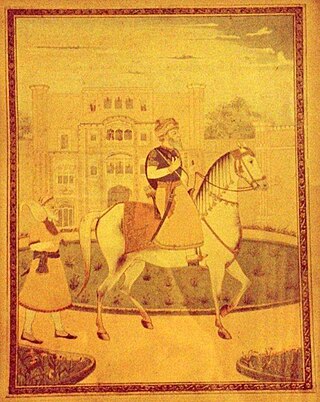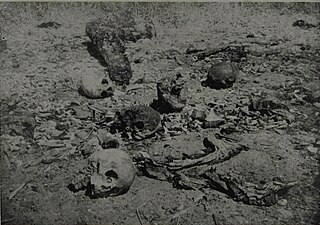The Mohmand or Momand is a prominent tribe of Pashtun people.

Sardar Mohammad Azim Khan Barakzai was a Pashtun noble who served as Afghan governor of Kashmir (1812–1819). He was the second son of the Barakzai chief Payinda Sarfaraz Khan, while his elder brother Fateh Khan was kingmaker and Vizier to Mahmud Shah Durrani. He was one of 21 brothers from eight mothers including his half-brother Dost Mohammad Khan who would later become Emir of Afghanistan.

Sultan-ul-Qaum Sardar Jassa Singh Ahluwalia was a Sikh leader during the period of the Sikh Confederacy, being the Supreme Leader of the Dal Khalsa. He was also Misldar of the Ahluwalia Misl. This period was an interlude, lasting roughly from the time of the death of Banda Bahadur in 1716 to the founding of the Sikh Empire in 1801. He founded the Kapurthala State in 1772.

Sirhind is a city and Sikh pilgrimage site in Punjab, India. It is situated on the Delhi to Lahore Highway. It has a population of about 60,851 . It is now a district headquarters in the state of Punjab; the name of the district is Fatehgarh Sahib.

Vadda Ghalughara was the mass murder of unarmed Sikhs by the Afghan forces of the Durrani Empire during the years of Afghan influence in the Punjab region of the Indian subcontinent owing to the repeated incursions of Ahmad Shah Durrani in February 1762. It is distinguished from the Chhota Ghalughara. Mostly non-combatants were killed in the event, and an estimated that 10,000 to 50,000 Sikhs were killed on 5 February 1762.

The Battle of Nowshera was fought in Nowshera in March 1823 between the Yusufzai Afghans, supported by the Peshawar sardars, alongside Azim Khan Barakzai, the Afghan governor of Peshawar, where they would face the Sikh armies led by Maharaja Ranjit Singh. Azim Khan was a half-brother of Dost Mohammad Khan, future ruler of Kabul, and later Afghanistan. The battle was a victory for the Sikhs, successfully defeating Azim Khan's armies. This victory allowed them to begin to their occupation of the Peshawar Valley.

Sardar Charat Singh, also romanised as Charhat Singh, was the founder of Sukerchakia Misl and father of Mahan Singh, and the grandfather of Ranjit Singh. He distinguished himself at an early age in campaigns against Ahmad Shah Abdali and along with 150 horsemen split from the Singhpuria Misl to establish the Sukerchakia Misl.

The Afghan–Sikh wars spanned from 1748 to 1837 in the Indian subcontinent, and saw multiple phases of fighting between the Durrani Empire and the Sikh Empire, mainly in and around Punjab region. The conflict's origins stemmed from the days of the Dal Khalsa, and continued after the Emirate of Kabul succeeded the Durrani Empire.
Zain-ud-Din Khan known as Zain Khan Sirhindi was the Mughal Faujdar of Sirhind, he was a serviceman of Shah Alam II, an ally of Najib-ud-Daula and Ahmad Shah Durrani. Zain Khan Sirhindi fought during the Third Battle of Panipat and strengthened Mughal rule in the region.

The Afghan-Maratha War was fought between the Afghan Empire under Ahmad Shah Durrani and the Maratha Empire and the Sikh Confederacy between 1758 and 1761. It took place in north-west India, primarily the region around Delhi and Punjab.
The Battle of Kup was fought on 5 February 1762, between the Afghan forces of Ahmad Shah Durrani and the Sikhs, under the command of Jassa Singh Ahluwalia and Charat Singh. Ahmad Shah Durrani and the Afghan forces reached Malerkotla, west of Sirhind. Different sources give various estimates on how many sikhs were present. According to Tom Landsford, nearly 30,000 Sikh men, women, children, and elderly laid encamped. According to Narendra Sinha, 40,000 Sikhs were present. According to Hari Ram Gupta, 50,000 Sikh soldiers laid encamped at Kup while 5,000 non combatants laid encamped at Pind Garma. Abdali's forces outnumbered the Sikhs in hand-to-hand combat and the Sikhs couldn't use their usual tactics of hit and run, but had to engage in battle while protecting the civilians at the same time. With surprise attack, the Sikhs threw a human ring around civilians as protection and fought the battle killing several thousand Afghans. Abdali was able to break the ring and carried out a full scale massacre of the Sikh civilians. Ahmad Shah's forces killed several thousand Sikhs, and the surviving Sikhs fled to Barnala. According to various different estimates, as many as 5,000 to 30,000 Sikh men, women, elderly and children were killed in what is known as the second Sikh genocide.
The Battle of Sialkot took place on 12 November 1763, between the Durrani Empire, led by Jahan Khan, and the Sukerchakia Misl, led by Charat Singh, as part of the Afghan-Sikh wars which concluded with Sikh victory.

Ahmad Shah Durrani, the founder of the Durrani Empire, invaded Indian subcontinent for eight times between 1748 and 1767, following the collapse of Mughal Empire in the mid-18th century. His objectives were met through the raids and deepened the political crisis in India.
The Battle of Manupur was fought between the Mughal Empire and the Durrani Empire in March 1748 near Sirhind which ended in victory for the Indian coalition.
The Battle of Sirhind was fought between Durrani Empire and Sikh Misls on 14 January 1764.

The Battle of Amritsar, also known as the Battle of Gohalwar, was fought between the Durrani Empire and Shaheedan Misl of the Dal Khalsa on 11 November 1757. Following the fourth invasion of Ahmad Shah Durrani, his army was attacked by Sikh bands under the command of Ala Singh and Baba Deep Singh. Following the attacks, Ahmad Shah desecrated the Sikh holy site known as the Shri Harmandir Sahib in Amritsar. The news of the desecration reached Baba Deep Singh who vowed to liberate the holy site from the Afghans. This resulted in a pitched battle being fought in the village of Gohalwar, near Amritsar. The battle resulted in Baba Deep Singh being killed and an Afghan victory.
Sardar Chuhar Singh of Jharauli was a general of Shaheedan Misl. He was the paternal cousin of Rai Singh Bhangi and close relative of Sikh warrior Baba Deep Singh. Under the command of Jassa Singh Ahluwalia, he fought for Shaheedan Misl in the Battle of Sirhind (1764) against Mughal Faujdar of Sirhind, Zain Khan Sirhindi. He secured Jharauli, Fatehgarh Atri, Ajrana and seven other villages by Markanda River. He had two sons, Karam Singh and Mohar Singh. The younger Mohar Singh took charge of the Jharauli estate. His elder son Karam Singh took control of the family estate at Chung that was finally incorporated to Lahore Darbar by issueless Ranjit Singh after his death in 1808. Mohar Singh lost seven villages of the Jharauli estate to Bhunga Singh of Thanesar in 1780. The Jharauli estate remained under the Court of Wards during 1885-1893 and again between 1922-1947.
The Battle of Mahilpur was fought between the Sikh Misls and Adina Beg Khan against the Durrani Empire in December 1757.Following the 4th invasion of Ahmad Shah Durrani, he would appoint Timur Shah as the viceroy of Punjab with Jahan Khan as his deputy.The Afghans would appoint Adina Beg Khan as the faujdar of the Jalandhar Doaba and exempted him from attending court at lahore, on the condition that Adina Beg pay revenue to the Afghan government.Soon a dispute regarding the payment of revenue occurred between Adina Beg and the Afghans.This dispute soon escalated which resulted in Jahan Khan sending an Afghan force to arrest Adina Beg.Adina Beg formed a military alliance with the Sikhs under the command of Jassa Singh Ahluwalia and Vadbhag Singh Sodhi.Adina Beg also gained the support of Sadiq Beg Khan, Khwaja Mirza Khan, and Raja Bhup Singh.Adina Beg along with the Sikh forces fought the Afghans at Mahilpur.The battle resulted in a victory for Adina Beg and the Sikhs and resulted in the entire Jalandhar Doaba being occupied and sacked by the Sikh forces.
The Battle of Chamkaur was fought in January 1764 by Sikh forces led by Jassa Singh Ahluwalia and Afghan forces led by Lachhmi Narain.

The Sikh Invasion of Ganga-Yamuna was the first Sikh Incursion in the neighbouring Doab. It took place right after the Sikh Conquest of Sirhind 1764, where the Durrani Governor Zain Khan Sirhindi was killed. Driven by this Victory, Sikhs under the Leadership of Jassa Singh Ahluwalia invaded the Upper Doab.










